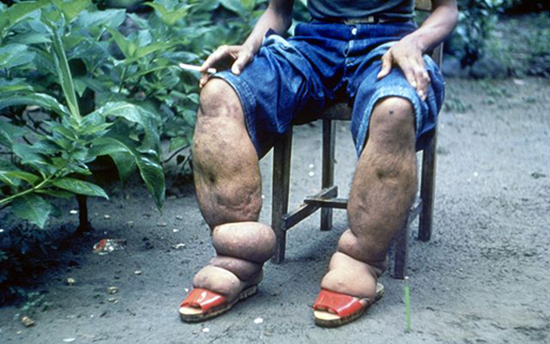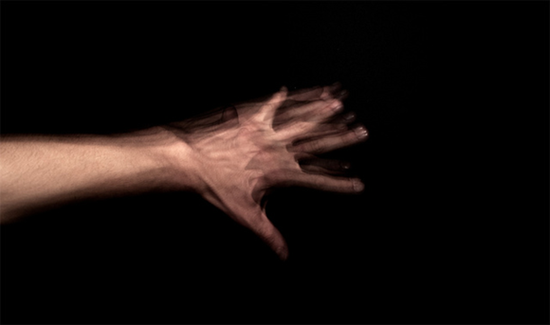
Treemen and zombies and werewolves, oh my! These things may sound like fiction, but they are very real to those affected by certain rare diseases. Here are 10 of the most bizarre medical conditions out there:
1. Fibrodysplasia ossificans progressiva, “Stone Man Syndrome”
Image: Joh-co via Wikimedia Commons
Fibrodysplasia ossificans progressiva (FOP) is a progressive genetic disorder that turns soft tissues into bone over time. The ACVR1 gene found in bone, muscles, tendons, and ligaments regulates growth and development of those tissues, and is responsible for turning cartilage into bone as children develop. However, mutations of this gene can allow ossification to go unchecked, even turning skeletal muscle into bone and causing joints to fuse together. Essentially, a sufferer of FOP turns into a statue from the inside out.
This disorder occurs in about 1 in 2 million people, and there are currently no treatments or cures. Trauma exacerbates the condition, so attempts to remove bone surgically just results in the body producing even more bone in the area.
2. Cotard’s Delusion, “Walking Corpse Syndrome”
“Zombie!” by Daniel Hollister via flickr, CC BY 2.0
Cotard’s Delusion isn’t a physical affliction, but a rare mental disorder in which a person sincerely believes he or she is missing body parts - such as the brain - or is actually dead. Sufferers tend not to eat or bathe, and they often spend time in cemeteries, wishing to be among their own kind. Well, their perceived own kind, at any rate.
This disorder has been connected to a dysfunction in the areas of the brain responsible for recognizing and associating emotions with faces, including their own. This causes a complete emotional detachment and removes any sense of personal identity when looking at their bodies. Medications can be used to treat the condition, though electroconvulsive therapy has worked better in some cases.
3. Cold Urticaria, “Cold Allergy”
“Cold” by RachelEllen via flickr, CC BY-NC-SA 2.0
With winter just around the corner for those of us in the Northern Hemisphere, those who suffer from cold urticaria need to be prepared. Contact to cold air or water can trigger a histamine reaction, just like an allergy to bees or peanuts. This can cause itchy hives and swelling in the affected areas. Those who have severe conditions can experience extreme swelling of the throat and tongue, which can actually be fatal.
It isn’t clear what causes this condition, though it can be treated with common antihistamines used for those who suffer from pet or seasonal allergies.
4. Epidermodysplasia Verruciformis, Lewandowsky-Lutz dysplasia, “Tree Man Syndrome”

What appears to be tree bark growing out of someone’s skin may actually be Epidermodysplasia verruciformis. Of course, it isn’t bark. These growths are actually warts that can be exacerbated by exposure to sunlight. While these warts may be benign early in life, they can become malignant later in life.
The warts are caused by a rare mutation of the EVER1/EVER2 genes. Though the function of the genes isn’t really well-understood, the mutations cause the skin to be extremely susceptible to human papillomaviruses 5 and 8, which typically don’t cause disease. While there are some treatment options available to mitigate the symptoms, there is no cure.
5. Xeroderma Pigmentosum, “Vampire Syndrome”
Image: NASA/SDO
Humans need sunlight to synthesize vitamin D, but too much exposure to the Sun’s UV rays can damage the skin. Approximately 1 in 1 million people have xeroderma pigmentosum and are extremely sensitive to UV rays. These people must be completely shielded from sunlight, or will experience extreme sunburns and breakdown of the skin. If someone with the condition isn’t careful, they could easily develop skin cancer.
Xeroderma pigmentosum is caused by a rare recessive mutation of the nucleotide excision repair enzymes. Functioning normally, these enzymes correct damaged DNA that can be caused by UV rays. For those with this condition, the enzymes do not work properly and DNA damage persists and accumulates. While there are some treatments available, the best prevention from damage is merely staying completely out of sunlight, just like a vampire.
6. Elephantiasis
Image: CDC via Wikimedia Commons
Elephantiasis is an obstruction of lymphatic vessels which causes extreme swelling of skin and tissues, typically in the legs or testicles. This disfiguring condition can be brought about in several ways, though a mosquito-borne parasite is the most common cause. Over 40 million people have been affected by the condition.
There are medications available to kill the parasite, so early intervention will produce the best result. There are surgical options if the elephantiasis affects the testicles, but not the limbs.
7. Hypertrichosis, “Werewolf Syndrome”
Image: Darren and Brad via flickr, CC BY-NC 2.0
While many women may pluck their eyebrows to remove a few unsightly stray hairs, those who suffer from hypertrichosis have abnormal hair growth covering their bodies. Faces can be completely covered in long hair, which is why the condition has earned the nickname of “werewolf syndrome.”
Hypertrichosis can be either congenital or acquired. Those born with the condition can suffer from one of several known genetic mutations. Some who get the condition later in life acquired it as a side effect from anti-balding treatments (be careful what you wish for…), though there are some who do not have an obvious cause. Treatment options include traditional methods of hair removal, though even waxing and laser treatments typically don’t provide long-lasting results.
8. Aquagenic urticaria, “Water Allergy”
“Water Texture” by Ian Britton via flickr, CC BY-NC 2.0.
As the majority of our body is made out of water, it seems odd that an allergy to it would even exist. Though it isn’t a true allergy because it doesn’t trigger a histamine response, there are some who develop itchy hives and welts even after mere minutes of water exposure.
There have been fewer than 100 documented cases of this condition, and the cause isn’t well known. Some have speculated that the water itself isn’t the cause, but rather specific chemicals or impurities that are ubiquitous within water. The most common treatment is topical application of capsaicin, which is used to relieve pain.
9. Alien Hand Syndrome
“Day 13. Alien Hand Syndrome” by Egidio Levendale via flickr, CC BY-NC-ND 2.0.
The phrase, “the right hand doesn’t know what the left is doing” is actually literally true for some people. This condition involves a rogue hand that acts independently, grasping objects or moving in a way contrary to what the individual wishes to do.
Sometimes, a rare side effect to brain injuries or surgical severing of the corpus callosum is the inability to control the actions of one hand. There is no cure for this condition, though the symptoms can be managed by making sure the hand is actively engaged in activity.
10. Foreign Accent Syndrome
“Bastille Day London 2012 - 03” by Garry Knight via flickr, CC BY-SA 2.0.
Accents can reveal a lot of information about where someone is from, and nearly everyone has tried to speak with an accent foreign to their native region. However, some people develop a condition that causes them to uncontrollably speak in a foreign accent, even if they have never visited that area before. Often, several types of accents can be used at different times, or may even be blended together.
This rare disorder typically comes about as a side effect following stroke or other brain injury. The person with the condition not only changes the tone of voice, but will also change tongue placement during speech. The only treatment for this condition is extensive speech therapy to retrain the brain to speak in a certain way.









No comments:
Post a Comment
Please adhere to proper blog etiquette when posting your comments. This blog owner will exercise his absolution discretion in allowing or rejecting any comments that are deemed seditious, defamatory, libelous, racist, vulgar, insulting, and other remarks that exhibit similar characteristics. If you insist on using anonymous comments, please write your name or other IDs at the end of your message.